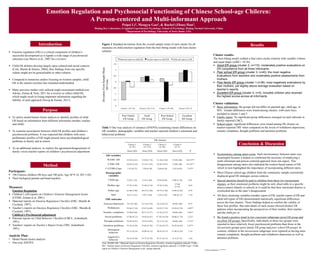
poster example 1
- 1. Emotion regulation (ER) is a critical component of children’s successful development as it signals a wide range of psychosocial outcomes (see Morris et al., 2007 for a review). Child ER abilities develop largely upon cultural and social contexts (Cole, Martin & Dennis, 2004), thus findings from one specific culture might not be generalizable to other cultures. Compared to numerous studies focusing on western samples, child ER in the eastern societies has remained understudied. Many previous studies only utilized single-assessment method (see Adrian, Zeman & Veits, 2011 for a review) to reflect child ER, which might result in losing important information regarding the liability of each approach (Suveg & Zeman, 2011). Emotion Regulation and Psychosocial Functioning of Chinese School-age Chileren: A Person-centered and Multi-informant Approach Peipei Li1, Mengyu Gao2, & Rachel (Zhuo) Han3, 1Beijing Key Laboratory of Applied Experimental Psychology, School of Psychology, Beijing Normal Universoty, China 2 Department of Psychology, University of Notre Dame, USA To utilize model-based cluster analysis to identify profiles of child ER based on information from different informants (mother, teacher and child) . To examine associations between child ER profiles and children’s psychosocial problems. It was expected that children with more problematic profiles of ER might present more psychopathological problems in family and at school. As an additional analysis, to explore the agreement/disagreement of family versus teacher reports on children’s psychosocial adjustment Participants: 196 Chinese children (96 boys and 100 girls; Age M=9.14, SD=1.02) Their biological parents and head teachers . Introduction Purpose Method Conclusion & Discussion Measures: Emotion Regulation Children’s self-reports on Children’s Emotion Management Scales (CEMS; Zeman et al. 2001). Maternal reports on Emotion Regulation Checklist (ERC; Shields & Cicchetti, 1997). Teacher’s reports on Emotion Regulation Checklist (ERC; Shields & Cicchetti, 1997). Children’s Psychosocial adjustment Paternal reports on Child Behavior Checklist (CBCL; Achenbach, 1991). Teachers’ reports on Teacher’s Report Form (TRF; Achenbach, 1991). Analytic Plan: • Model based cluster analysis • One-way ANOVA Inconsistency among raters exists. Such inconsistency between raters was meaningful because it helped us confirmed the necessity of employing a multi-informant and person-centered approach from one aspect. This disagreement among raters also indicated the context-based nature of ER, which in turn highlighted the importance of incorporating different raters. Most Chinese school-age children from the community sample consistently displayed good ER strategies across contexts. Special attention should be paid to children from these two inconsistent clusters, as their emotional problems might be only observable in a specific micro-context (family or school) or it could be that their emotional distress is overlooked due to the rater’s disagreement. All three clustering variables (mother report of ER, teacher report of ER and child self report of ER) demonstrated statistically significant differences across the four clusters. These findings helped us confirm the validity of these four profiles: that individuals of each cluster showed distinct ER patterns when incorporating the perspectives of their mother, their teacher and the child per se. We found a positive trend in two consistent subgroups (good ER group and excellent ER group). Specifically, individuals in these two groups were reported to have relatively fewer psychosocial problems than those in the inconsistent groups (poor family ER group and poor school ER group). In contrast, children in the inconsistent subgroups were reported as having more somatic complaints, thought problems and withdrawn depression as well as attention problems *Acknowledgement. ******. Figure 1 Standard deviations from the overall sample mean of each cluster for all measures on child emotion regulation from the best fitting model with four-cluster solution. Table 1 One-way analysis of variance (ANOVA) examining cluster differences on ER variables, demographic variables and teacher reported children’s emotional and behavioral problems DeviationFromSampleMean SDUnits Poor Family ER Group Good ER Group Poor School ER Group Excellent ER Group Results Note: M-ERC-ER = Maternal report on Emotion Regulation Checklist, emotion regulation subscale; T-ERC- ER = Teacher report on Emotion Regulation Checklist, emotion regulation subscale; C-CEMS-Cope = Child report on Children’s Emotion Management scale, coping subscale. Cluster results: The best-fitting model yielded a four-class cluster solution with variable volume and equal shape (△BIC= 10.26). Good ER group (cluster 2; n=115): moderately positive evaluations on ER competence from all three informants. Poor school ER group (cluster 3; n=40): the most negative evaluations from teachers and moderately positive assessments from mothers. Poor family ER group (cluster 1;n=36): most negatively evaluations by their mothers, yet slightly above average evaluation based on teacher’s reports. Excellent ER group (cluster 4; n=5): included children who received the highest scores across all informants Cluster validation: Basic information: the groups did not differ on parental age, child age, or SES. Gender differences were found among clusters, with more boys included in cluster 1 and 3. Family report: No significant group differences emerged on each subscale in family reported CBCL. School report: significant differences were found among ER clusters on teacher-reported TRF when compared on the levels of withdrawn depression, somatic complains, thought problems and attention problems.